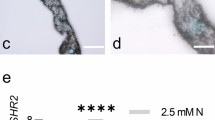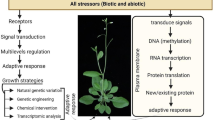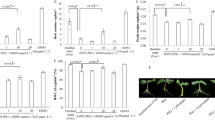Abstract
Ascorbic acid (Asc) plays a multifunctional role in plants. l-galactono-1,4-lactone dehydrogenase (GLDH, EC 1.3.2.3) catalyzes the last step in the main pathway of Asc biosynthesis in higher plants. In this paper, we first examined how a change in Asc content leads to a changed plant growth and seed set using GLDH transgenic rice (Oryza sativa L.) which has different expression level of GLDH. The results showed that suppression of GLDH expression resulted in a loss of chlorophyll, a lower Ribulose 1,5-bisphosphate carboxylase/oxygenase (Rubisco, EC 4.1.1.39) protein content, and a lower rate of CO2 assimilation. As a consequence, a slower rate of plant growth and lower seed set were observed. Reduced seed set and growth rate as measured by plant height, root length, leaf weight, and root weight were consistent with the GLDH-mediated reduction of photosynthetic function. Increasing GLDH expression maintained high levels of chlorophyll, Rubisco protein, and a higher rate of net photosynthesis, resulting in higher seed set. The observation that increasing the level of GLDH expression correlated with reduced lipid peroxidation whereas reducing GLDH expression correlated with increased lipid peroxidation was consistent with the foliar level of Asc, indicating that GLDH functions to protect against ROS-mediated damage. When taken together, this work suggests that level of Asc in transgenic rice for GLDH is associated with plant growth and seed set.







Similar content being viewed by others
References
Alhagdow M, Mounet F, Gilbert L, Nunes-Nesi A, Garcia V, Just D, Petit J, Beauvoit B, Fernie AR, Rothan C (2007) Silencing of the mitochondrial ascorbate synthesizing enzyme l-galactono-1, 4-lactone dehydrogenase affects plant and fruit development in tomato. Plant Physiol 145:1408–1422. doi:10.1104/pp.107106500
Arnon DI (1949) Complex enzymes in isolated chloroplasts: polyphenol oxidase in Beta vulgaris. Plant Physiol 24:1–15. doi:10.1104/pp.24.1.1
Arrigoni O, De Tullio MC (2002) Ascorbic acid: much more than just an antioxidant. Biochim Biophys Acta 1569:1–9. doi:10.1016/S0304-4165(01)00235-5
Barth C, De Tullio M, Conklin PL (2006) The role of ascorbic acid in the control of flowering time and the onset of senescence. J Exp Bot 57:1657–1665. doi:10.1093/jxb/erj198
Bartoli CG, Pastori GM, Foyer CH (2000) Ascorbate biosynthesis in mitochondria is linked to the electron transport chain between complexes III and IV. Plant Physiol 123:335–343. doi:10.1104/pp.123.1.335
Bartoli CG, Guiamet JJ, Kiddle G, Pastori GM, Di Cagno R, Theodoulou FL, Foyer CH (2005) Ascorbate content of wheat leaves is not determined by maximal l-galactono-1,4-lactone dehydrogenase (GalLDH) activity under drought stress. Plant Cell Environ 28:1073–1081. doi:10.1111/j.1365-3040.2005.01338.x
Bartoli CG, Yu J, Gomez F, Fernandez L, McIntosh L, Foyer CH (2006) Inter-relationships between light and respiration in the control of ascorbic acid synthesis and accumulation in Arabidopsis thaliana leaves. J Exp Bot 57:1621–1631. doi:10.1093/jxb/erl005
Blokhina O, Virolainen E, Fagerstedt KV (2003) Antioxidants, oxidative damage and oxygen deprivation stress: a review. Ann Bot 91:179–194. doi:10.1093/aob/mcf118
Borraccino G, Mastropasqua L, De Leonardis S, Dipierro S (1994) The role of the ascorbic acid system in delaying the senescence of oat (Avena saliva L.) leaf segments. J Plant Physiol 144:161–166
Conklin PL (2001) Recent advances in the role and biosynthesis of ascorbic acid in plants. Plant Cell Environ 24:383–394. doi:10.1046/j.1365-3040.2001.00686.x
Conklin PL, Williams EH, Last RL (1996) Environmental stress sensitivity of an ascorbic acid-deficient Arabidopsis mutant. Proc Natl Acad Sci USA 93:9970–9974. doi:10.1073/pnas.93.18.9970
Conklin PL, Norris SR, Wheeler GL, Williams EH, Smirnoff N, Last RL (1999) Genetic evidence for the role of GDP-mannose in plant ascorbic acid (vitamin C) biosynthesis. Proc Natl Acad Sci USA 96:4198–4203. doi:10.1073/pnas.96.7.4198
Dowdle J, Ishikawa T, Gatzek S, Rolinski S, Smirnoff N (2007) Two genes in Arabidopsis thaliana encoding GDP-l-galactose phosphorylase are required for ascorbate biosynthesis and seedling viability. Plant J 52:673–689. doi:10.1111/j.1365-313X.2007.03266.x
Horemans N, Potters G, De Wilde L, Caubergs RJ (2003) Dehydroascorbate uptake activity correlates with cell growth and cell division of tobacco bright yellow-2 cell cultures. Plant Physiol 133:361–367. doi:10.1104/pp.103.022673
Imai T, Karita S, Shiratori G, Hattori M, Nunome T, Oba K, Hirai M (1998) l-Galactono-γ-lactone dehydrogenase from sweet potato: purification and cDNA sequence analysis. Plant Cell Physiol 39:1350–1358. doi:10.1111/j.1399-3054.2006.00640.x
Ishikawa T, Dowdle J, Smirnoff N (2006) Progress in manipulating ascorbic acid biosynthesis and accumulation in plants. Physiol Plant 126:343–355. doi:10.1111/j.1399-3054.2006.00640.x
Kampfenkel K, Motagu MV, Inzé D (1995) Extraction and determination of ascorbate and dehydroascorbate from plant tissue. Anal Biochem 225:165–167. doi:10.1006/abio.1995.1127
Loewus FA (1999) Biosynthesis and metabolism of ascorbic acid in plants and of analogs of ascorbic acid in fungi. Phytochemistry 52:193–210. doi:10.1016/S0031-9422(99)00145-4
Makino A, Mae T, Ohira K (1986) Colorimetric measurement of protein stained with Coomassie Brilliant Blue R on sodium dodecyl sulfate-polyacrylamide gel electrophoresis by eluting with formamide. Agric Biol Chem 50:1911–1912
Makino A, Nakano H, Mae T (1994) Responses of ribulose-1,5-bisphosphate carboxylase, cytochrome f, and sucrose synthesis enzymes in rice leaves to leaf nitrogen and their relationships to photosynthesis. Plant Physiol 105:173–179. doi:10.1104/pp.105.1.173
Millar AH, Mittova V, Kiddle G, Heazlewood JL, Bartoli CG, Theodoulou FL, Foyer CH (2003) Control of ascorbate synthesis by respiration and its implications for stress responses. Plant Physiol 133:443–447. doi:10.1104/pp.103.028399
Mutsuda M, Ishikawa T, Takeda T, Shigeoka S (1995) Subcellular localization and properties of l-galactono-γ-lactone dehydrogenase in spinach leaves. Biosci Biotechnol Biochem 59:1983–1984. doi:10.1271/bbb.59.1983
Noctor G, Foyer CH (1998) A re-evaluation of the ATP: NADPH budget during C3 photosynthesis: a contribution from nitrate assimilation and its associated respiratory activity? J Exp Bot 49:1895–1908. doi:10.1093/jxb/49.329.1895
Oba K, Ishikawa S, Nishikawa M, Mizuno H, Yamamoto T (1995) Purification and properties of l-galactono-γ-lactone dehydrogenase, a key enzyme for ascorbic acid biosynthesis, from sweet potato roots. J Biochem 117:120–124
Olmos E, Kiddle G, Pellny TK, Kumar S, Foyer CH (2006) Modulation of plant morphology, root architecture, and cell structure by low vitamin C in Arabidopsis thaliana. J Exp Bot 57:1645–1655. doi:10.1093/jxb/erl010
Ostergaard J, Persiau G, Davey MW, Bauw G, Van Montagu M (1997) Isolation of a cDNA coding for l-galactono-γ-lactone dehydrogenase, an enzyme involved in the biosynthesis of ascorbic acid in plants: purification, characterization, cDNA cloning, and expression in yeast. J Biol Chem 272:30009–30016. doi:10.1074/jbc.272.48.30009
Pastori GM, Kiddle G, Antoniw J, Bernard S, Veljovic-Jovanovic S, Verrier PJ, Noctor G, Foyer CH (2003) Leaf vitamin C contents modulate plant defense transcripts and regulate genes that control development through hormone signaling. Plant Cell 15:939–951. doi:10.1105/tpc.010538
Pavet V, Olmos E, Kiddle G, Mowla S, Kumar S, Antoniw J, Alvarez ME, Foyer CH (2005) Ascorbic acid deficiency activates cell death and disease resistance responses in Arabidopsis. Plant Physiol 139:1291–1303. doi:10.1104/pp.105.067686
Pignocchi C, Fletcher JM, Wilkinson JE, Barnes JD, Foyer CH (2003) The function of ascorbate oxidase in tobacco. Plant Physiol 132:1631–1641. doi:10.1104/pp.103.022798
Pineau B, Layoune O, Danon A, De Paepe R (2008) l-galactono-1,4-lactone dehydrogenase is required for the accumulation of plant respiratory complex I. J Biol Chem 283:32500–32505. doi:10.1074/jbc.M805320200
Rayle DL, Cleland RE (1992) The acid growth theory of auxin-induced cell elongation is alive and well. Plant Physiol 99:1271–1274. doi:10.1104/pp.99.4.1271
Siendones E, Gonzalez-Reyes JA, Santos-Ocana C, Navas P, Cordoba F (1999) Biosynthesis of ascorbic acid in kidney bean: l-galactono-γ-lactone dehydrogenase is an intrinsic protein located at the mitochondrial inner membrane. Plant Physiol 120:907–912. doi:10.1104/pp.120.3.907
Smirnoff N (1996) The function and metabolism of ascorbic acid in plants. Ann Bot 78:661–669. doi:10.1006/anbo.1996.0175
Smirnoff N, Wheeler GL (2000) Ascorbic acid in plants: biosynthesis and function. Crit Rev Plant Sci 19:267–290. doi:10.1016/S0735-2689(00)80005-2
Sunkar R, Bartels D, Kirch HH (2003) Overexpression of a stress-inducible aldehyde dehydrogenase gene from Arabidopsis thaliana in transgenic plants improves stress tolerance. Plant J 35:452–464. doi:10.1046/j.1365-313X.2003.01819.x
Tabata K, Oba K, Suzuki K, Esaka M (2001) Generation and properties of ascorbic acid-deficient transgenic tobacco cells expressing antisense RNA for l-galactono-1,4-lactone dehydrogenase. Plant J 27:139–148. doi:10.1046/j.1365-313x.2001.01074.x
Tamaoki M, Mukai F, Asai N, Nakajima N, Kubo A, Aono M, Saji H (2003) Light-controlled expression of a gene encoding l-galactono-γ-lactone dehydro -genase which affects ascrobate pool size in Arabidopsis thaliana. Plant Sci 164:1111–1117. doi:10.1016/S0168-9452(03)00122-5
Tokunaga T, Miyahara K, Tabata K, Esaka M (2005) Generation and properties of ascorbic acid-overproducing transgenic tobacco cells expressing sense RNA for l-galactono-1,4-lactone dehydrogenase. Planta 220:854–863. doi:10.1007/s00425-004-1406-3
Veljovic-Jovanovic SD, Pignocchi C, Noctor G, Foyer CH (2001) Low ascorbic acid in the vtc-1 mutant of Arabidopsis is associated with decreased growth and intracellular redistribution of the antioxidant system. Plant Physiol 127:426–435. doi:10.1104/pp.010141
Wang ZN, Xiao Y, Chen WS, Tang KX, Zhang L (2010) Increased vitamin C content accompanied by an enhanced recycling pathway confers oxidative stress tolerance in Arabidopsis. J Integr Plant Biol 52:400–409. doi:10.1111/j.1774-7909.2010.00921.x
Wheeler GL, Jones MA, Smirnoff N (1998) The biosynthetic pathway of vitamin C in higher plants. Nature 393:365–369. doi:10.1038/30728
Yabuta Y, Yoshimura K, Takeda T, Shigeoka S (2000) Molecular characterization of tobacco mitochondrial l-galactono-1,4-lactone dehydrogenase and its expression in Escherichia coli. Plant Cell Physiol 41:666–675. doi:10.1093/pcp/41.6.666
Yoshida S, Forno DA, Cock JH, Gomez KA (1976) Laboratory manual for physiological studies of rice, 3rd edn. International Rice Research Institute, Philippines
Yu L, Jiang JZ, Zhang C, Jiang LR, Ye NH, Lu YS, Yang GZ, Liu EE, Peng CL, He ZH, Peng XX (2010) Glyoxylate rather than ascorbate is an efficient precursor for oxalate biosynthesis in rice. J Exp Bot 61:1625–1634. doi:10.1093/jxb/erq028
Acknowledgments
The authors are very grateful to Professor Xingxiang Peng (South China Agricultural University, China) for the generous gift of rice seeds. This work was supported by the National Natural Science Foundation of China (30600049).
Author information
Authors and Affiliations
Corresponding author
Additional information
Communicated by L. Kleczkowski.
Rights and permissions
About this article
Cite this article
Liu, Y., Yu, L. & Wang, R. Level of ascorbic acid in transgenic rice for l-galactono-1,4-lactone dehydrogenase overexpressing or suppressed is associated with plant growth and seed set. Acta Physiol Plant 33, 1353–1363 (2011). https://doi.org/10.1007/s11738-010-0669-5
Received:
Revised:
Accepted:
Published:
Issue Date:
DOI: https://doi.org/10.1007/s11738-010-0669-5




